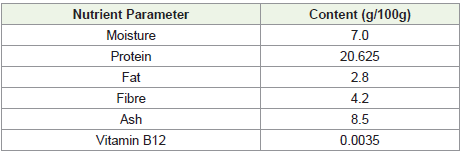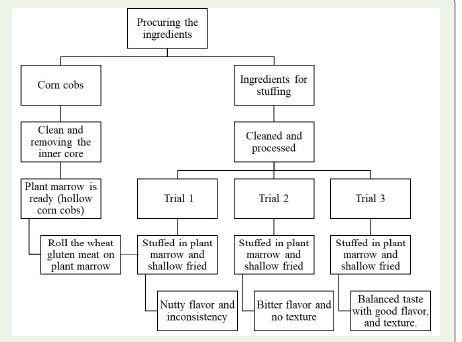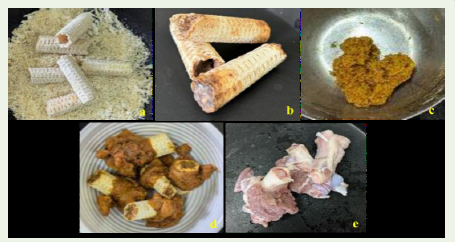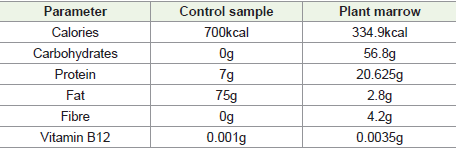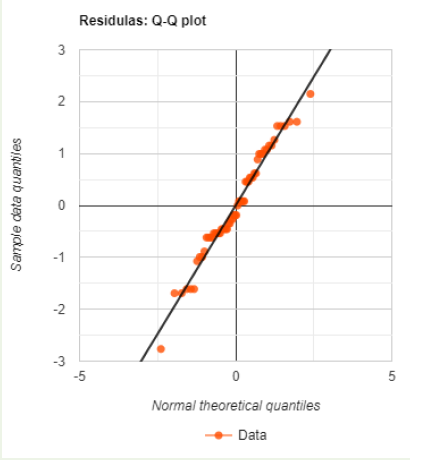Research article
Plant Marrow with Gluten Meat as an Alternative to Animal Meat
Sreedharshini K1, Akash R1, Sujatha B2*, Anuradha M3, Indu BK3 and Sharad S. Achar3
1Department of Food Technology, Padmashree Institute of Management and Sciences, Kommaghatta, Bangalore, Karnataka, India.
2Department of Food Technology, Padmashree Institute of Management and Sciences, Kommaghatta, Bangalore, Karnataka, India.
3Department of Biotechnology, Padmashree Institute of Management and Sciences, Kommaghatta, Bangalore, Karnataka, India.
*Corresponding author:B. Sujatha, Assistant Professor, Department of Food Technology, Padmashree Institute of Management and Sciences, Kommaghatta, Bangalore, Karnataka, India. E-mail Id: sujathabachu80@gmail.com
Article Information:Submission: 19/12/2024; Accepted: 13/01/2025; Published: 17/01/2025
Copyright: ©2025 Sreedharshini K, et al. This is an open access article distributed under the Creative Commons Attribution License, which permits unrestricted use, distribution, and reproduction in any medium, provided the original work is properly cited.
Abstract
Increasing inclination towards vegan and vegetarian foods has led to the development of plant-based meat products. Bone marrow of meat is generally consumed by non-vegetarians for its nutritional value. As this is difficult for vegetarians, this study aimed to develop a plant marrow (corn cobs) incorporating
oyster mushroom, roasted cashew nut, wheat gluten, and spices. The plant marrow was evaluated in three trials and tested for its proximate composition and sensory characteristics. Proximate analysis revealed the presence of 20.6% protein, 2.8% fat, 4.2% fibre, 7.0% moisture, 8.5% ash, and 56.8% carbohydrates
in the final product.This indicated a well-balanced nutritional profile compared to natural animal meat. Sensory evaluation by an untrained panel provided high mean scores for appearance (7.55), taste (8.1), aroma (8.5), and texture (7.8), reflecting high consumer acceptability. Hence, this product can be considered
a meat alternative for health-conscious consumers. Further studies can enhance the acceptability and texture of this food product along with efficient methods for packaging and increasing the shelf-life.
Keywords:Plant Marrow; Corn Cob; Plant-Based Meat; Vegetarian; Oyster Mushroom
Introduction
The terms vegetarians and vegan trace their roots to the ancient
Latin word ‘vegetus’, meaning healthy and vigorous. Vegetarianism
excludes meat, fish, and their derivatives, whereas veganism is a
stricter form and eliminates all animal products.Driven by ethical,
environmental, and health concerns, plant-based diets have gained
significance. Interestingly, the market for plant-based proteins is
gaining huge popularity and is being followed worldwide. Since
the bone marrow of meat is rich in fats, it could lead to the onset of
overweight, obesity, and other diseases. The rise of meat alternatives,
such as plant-based meat analogues, has fuelled the trend [1,2,3] of
consuming them. Meat analogues are plant-based food products that
resemble meat regarding sensory qualities [4,5,6]. The major concern
of plant-based meat analogues is food safety, as these products are
easily susceptible to microbial contamination. Overall, the growing
demand for sustainable and ethical food choices has led to the
emergence of plant-based meat analogues. The analogues, mentioned
in this study aim to replicate the taste, texture, and appearance of real
meat by replacing the meat marrow with corn cob marrow.
Materials and Methods
Preparation of plant marrow:
The corn cobs and other ingredients required for the study
were procured from the local market. The corn cobs were washed
thoroughly, and the outer layer was removed using a sharp knife and
later polished. The inner core of the cob was scooped out and dried in
an oven at 105°C for 20 minutes.Preparation of plant marrow stuffing and gluten meat:
The stuffed ingredients were mixed and sautéed for 10 minutes on
low flame. This mixture was then blended into a fine paste using an
electric blender and stuffed into the hollow corn cobs (plant marrow).
To imitate the visual appearance of animal meat, gluten flour was
mixed with corn starch and spices. This mixture was extruded using
an extrusion machine to the desired shape and rolled around the plant
marrow. This product was packed in air-tight containers and stored
at -18°C for further studies. Meanwhile,some of this product was
shallow fried using refined oil and subjected to sensory evaluation.Three trials were performed with variations in the stuffing of the
plant marrow. Trial 1 consisted of button mushrooms, eggplant paste,
salt, pepper, and coconut oil. Trial 2 consisted of oyster mushrooms,
drumstick pulp, spices, and agar agar. Trial 3 consisted of oyster
mushrooms, roasted cashew nuts, and spices.
Assessment of the product:
Sensory evaluation of the product was performed using a rating
card on a 9-point hedonic scale,wherein 1: dislike extremely to 9: like
extremely [7]. 30 Panellists were selected randomly and asked to taste
and rate the product unanimously.Proximate analysis of the product:
The moisture, protein, fat, ash, and vitamin B2 and B3 contents of
the food sample were determined in the proximate analysis.Moisture content was evaluated by evaporation method. Samples
were placed in an oven for 3 hours at 105°C. The weights of the samples
were measured before and after placing them in the oven. Protein was
calculated using the Kjeldahl method. The Kjeldahl method involved
placing a weighed sample of food product into the digestion flask and
digesting it with sulphuric acid, anhydrous sodium sulfate, and any
catalyst (copper salt). After digestion, the solution is made alkaline
by adding 40% sodium hydroxide to convert ammonium sulphate to
ammonia gas. This gas is mixed with boric acid and titrated with an
indicator to detect the endpoint [8].
The fat content of the food product was determined by the Soxhlet
method. The food product was dried, ground into small pieces, and
placed in a porous thimble. This thimble was placed in an extraction
chamber suspended above a solvent, and a Soxhlet was carried out.
At the end of the process, lipids remain in the flask, and the solvent is
removed by evaporation [9].
Ash content was estimated by sample incineration at high
temperatures (500°C to 600°C) in a muffle furnace [10].
Fibre content was estimated by considering 2.5g of moisture free
sample in a Soxhlet flask, and 200ml dilute sulphuric acid was
boiled and added to this. This mixture was refluxed and heated until
boiling was seen. The flask was rotated frequently, taking care that the
material would not stick to the sides of the flask and not to keep the
material out of contact with the acid. This boiling was carried out for
30 minutes and later filtered using linen. The filtrate was washed with
boiling water to remove the acidic content. Further, it was washed
in boiled sodium hydroxide for 30 minutes. Again, the mixture was
filtered, and the filtrate was washed with hot water, followed by 15 ml
of ethyl alcohol in the crucible with a lining of ignited asbestos. The
crucible contents were dried at 105°C in a hot air oven and cooled
to be weighed. The contents were incinerated in a crucible at 600°C.
The ash obtained from this was cooled and weighed again using the
formula crude fibre (percent by mass) = 10000 (M1-M2) M * (100 –
W) where M1 is the mass of the crucible and contents before ashing,
M2 is the mass of crucible with asbestos and ash, M is mass of material
taken for test, and W is the percentage of moisture [9].
Vitamin B12:The estimation of vitamin B12 was carried out by
standard protocols (Hung et al 1999). Vitamin B12 was prepared as
a working standard at 26.2 mg per 100 ml (10 μg of cobalt). This was
aliquoted in different concentrations from 2.5 to 17.5 μg/ml (of cobalt).
Similarly, samples were also considered at these concentrations, and
the same procedure was followed. Absorbance was recorded at 435
nm, and a standard graph was plotted [11].
Finally, a comparison test was performed between natural meat
(animal source) and plant-based meat (plant marrow). Both samples
were subjected to the same tests as mentioned earlier.
Statistical analysis:
The statistical tests for the sensory evaluation were carried out
to determine values such as mean, standard deviation, and residuals.
The ANOVA test was applied to identify the p-value and test the
hypothesis at the 0.05 significance level. A Q-Q plot was plotted to
test the deviation of the data from the mean values.Results and Discussions
Sensory evaluation:
The results of preparing the plant marrow and using three
different stuffing’s were evaluated by random individuals by sensory
tests. According to the hedonic scale responses and comments from
the sensory evaluation, trial 1 had more of a nutty flavour with an
unpleasant consistency. Trial 2 had a slightly bitter taste and altered
the flavour and texture. However, trial 3 had a satisfactory taste,
flavour, and texture. The gluten meat made of corn starch and wheat
gluten had an acceptable meat consistency and chewy texture. The
overall appearance of the final product was also appreciated as it
imitated the control set considered in the study.The flowchart of the
product development is mentioned in [Figure 1,2].The values of various parameters studied in the proximate
analysis is depicted in [Table 1]. The protein content was observed to
be highest, at 20.62g per 100g serving.
The observations of comparison from animal meat and plant based
meat products (per 100g) are mentioned in [Table 2] A clear
indication of decreased calories and fats is observed, along with
increased fibre content.
Figure 1:Flowchart of the procedure followed in developing the plant
marrow. Three trials involved in optimizing the stuffing used for plant marrow
and the observations made are mentioned in this flowchart. Incorporating the
gluten meat around the plant marrow for aesthetic appeal is also included
in the flowchart.
Figure 2:The making of plant marrow and comparison with the control. a:
Corn cobs cleaned and prepared for stuffing, b: corncobs filled with different
types of stuffing, c: imitation of the meat, made from wheat gluten and corn
starch, d: final product (shallow fried plant marrow and wheat gluten), e:
control sample for comparison.
Figure 3:The Q-Q plot of parameters considered in sensory evaluation. The plot was constructed using the online website statistics kingdom [10]. The data of sensory evaluation is scattered around the mean (straight line). The data is of the five parameters of sensory evaluation i.e.
a) Appearance; b) Taste; c) Aroma; d) Texture; e) Overall acceptance.
Proximate analysis:
Statistical analysisThe mean values calculated from each parameter in each trial are shown in [Table 3]. The ANOVA study revealed the p-value of the observations in all parameters to be lesser than 0.05, i.e., 95% significance level of alpha [Table 4]. Hence, we reject the null hypothesis (assuming the average of all the groups is equal)for all the parameters. The Q-Q plot of the same data is plotted and shown in [Figure 3]. It is evident from the Q-Q plot that the data points closely follow the mean value (straight line) and do not deviate much from the straight line, indicating a good distribution.
Conclusion
The three trials to decide the stuffing demonstrated the importance
of selecting appropriate ingredients for overall acceptability. In the
Table 4:P-values from the ANOVA analysis of appearance, taste, aroma, texture,
and overall acceptance.
first trial, their flavourdominated due to the coconut oil and cashew
nuts. In the second trial, the drumstick pulp and agar agar did not
complement each other, leading to bitterness. The third trial had a
balanced composition of ingredients (spices and roasted cashews),
and hence, a well-balanced taste profile was achieved. Adding corn
starch to the outer covering improves the consistency and appearance
of the fake meat. The added spices improve the flavour and make
the food more palatable. Zhang, 2023 have also summarized the
production, functions and limitations of plant-based meat products.
The authors have recommended on the usage of wheat gluten
for mimicking meat [13,14]. Though other studies [15-17] have attempted in the production of plant-based meat from various
sources, numerous ingredients have been utilized in the production
of such meat. Whereas here, fewer ingredients are used to produce a
meat analogue. Thus, this is an innovative food product obtained from
the combination of two different major ingredients working together
to offer an exquisite experience. The future of plant-based foods
looks promising by addressing consumer preferences, overcoming
technical challenges, and prioritizing food safety. However, rigorous
food safety practices are essential to ensure the quality and safety of
these alternatives.
Acknowledgements
The authors would like to thank The Principal and The Head
of the Department (Food Science and Technology) at Padmashree
Institute of Management and Sciences, Bengaluru, for their support
and cooperation during the conduct of this study.

